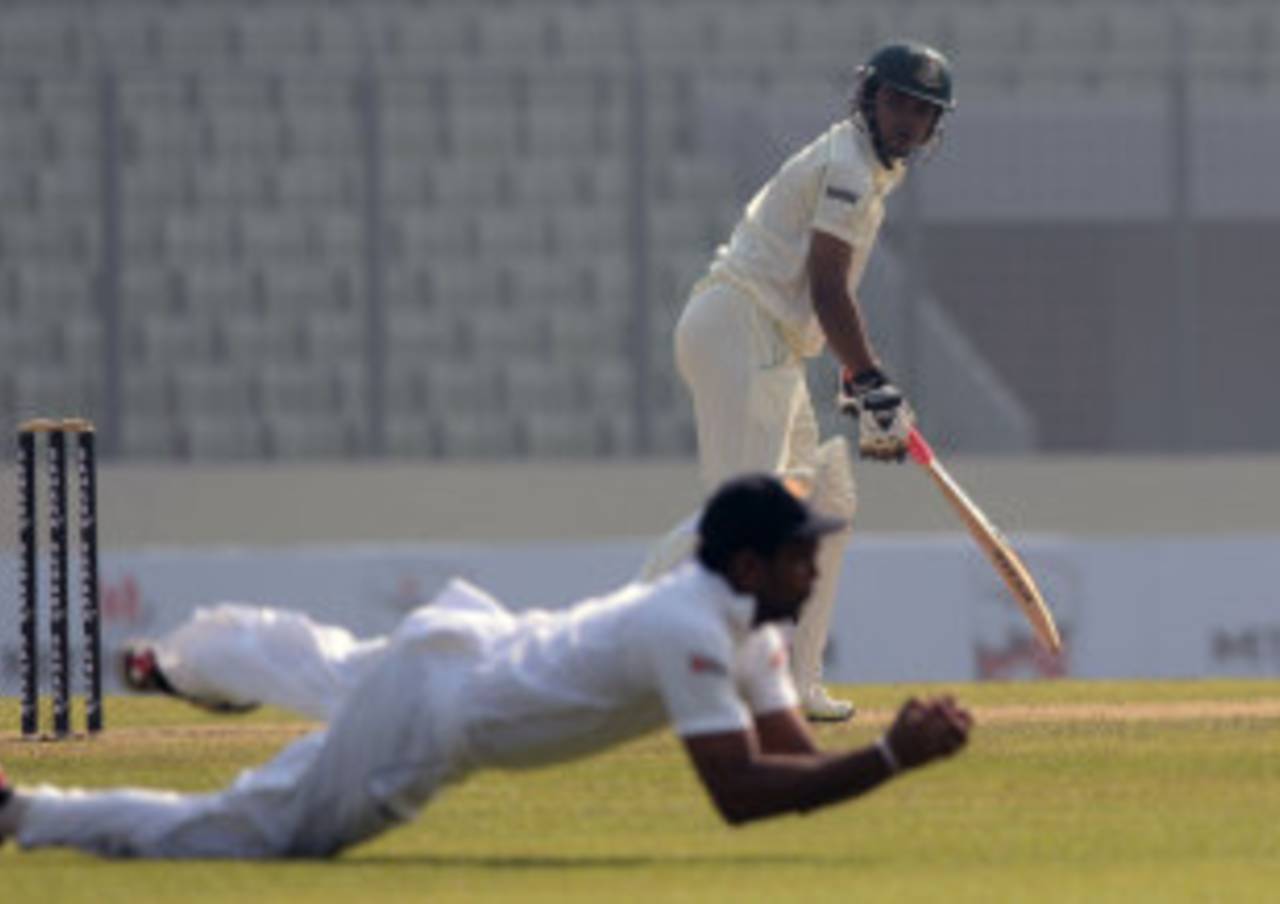Trouble at the top for Bangladesh
Bangladesh's collapse on the first day highlighted an ingrained problem in their Test batting, where they have failed to get to 100 without the loss of four wickets in 91 instances out of 161 Test innings
Mohammad Isam in Mirpur
27-Jan-2014

The Bangladesh top order struggled on the first day in Mirpur • AFP
Bangladesh have a top-order collapse roughly once every two innings. When Mominul Haque was dismissed, Bangladesh were 59 for 4 in the 18th over, and it became the 91st time out of 161 Test innings that Bangladesh's first four wickets fell before the score had reached hundred.
The easy assumption after the latest collapse would be to call it complacency, particularly after having a decent 2013 batting-wise and an even better previous Test series against New Zealand three months ago. The worst batting performance last year was in the first Test in Zimbabwe last April, when everyone surrendered to seam and the threat of a shorter length.
The same theme followed in this first innings as Shaminda Eranga and Suranga Lakmal bowled a shorter length and produced bounce from the Mirpur wicket with more wrist-action on the ball. All of the batsmen tried to play shots, but weren't manufacturing them, to their credit.
But the day's scorecard is dismissive enough of their batting approach. Monday's collapse was the result of bad habits, proper planning from the opposition and impetuous strokeplay, though the current top-order contains batsmen with more ability than it did in the past. Tamim Iqbal's hook shot didn't connect well, Marshall Ayub missed a ball that moved in just a bit, Shamsur Rahman played away from the body - his natural reaction to anything pitched up - and Mominul pulled the ball when he shouldn't have.
Bangladesh weren't too troubled by the bounce till they started pulling and hooking. Tamim is a naturally aggressive batsman, and could have taken the tougher route of hanging back and waiting for the bad ball. But as an opener who likes to go after the bowling, he thought the best way to answer Sri Lanka's stifling length would be attack the short ball. The result was a catch at long leg, but he would have tried it on most occasions.
Marshall is in need of runs at No. 3, Bangladesh's newest entry into that crucial spot. He is a natural middle-order batsman, but due to his technique and domestic runs, he was selected to plug this gap. He has the second innings left in this Test to prove his credentials, and that innings will be pivotal for his future.
Shamsur started off with edges, timed the ball for a while before he edged once more. For a debutant opener, he deserves more time to showcase his attacking approach at the crease.
These four wickets were followed by the routine recovery act. Shakib Al Hasan and captain Mushfiqur Rahim added 86 for the fifth wicket stand but when you start from 59, ending on 145 doesn't offer much help. The pair's approach should be followed however as they only went after short and wide ones, and batted within themselves during the partnership. This was the sort of discipline that Mushfiqur would have expected from the top four. Shakib started off quickly before reining in his strokes for the rest of the afternoon, until missing a sweep shot off Rangana Herath.
Mushfiqur got a borderline call when the ball appeared to take an inside edge, but replays proved inconclusive. His exit confirmed that Bangladesh would not have a lower-order resurrection, and when they were bowled out for 232, the blame laid squarely on the misfiring top-order.
Luckily, none of the Bangladesh top-order batsmen give excuses. Tamim is in a quest to achieve greater heights as a batsman while his new partner Shamsur has made 267 earlier this month, and is a heavily experienced domestic batsman. So is Marshall, while Mominul's recent record gives some assurance that he has the knack for a big score.
Most importantly, they have to make sure a second collapse is not repeated, and ensure that the short ball is handled a lot better the next time around.
Mohammad Isam is ESPNcricinfo's Bangladesh correspondent. He tweets here